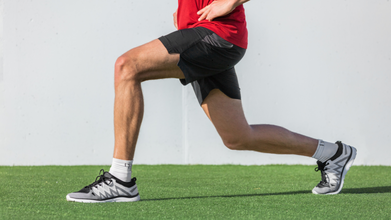- Health Conditions A-Z
- Health & Wellness
- Nutrition
- Fitness
- Health News
- Ayurveda
- Videos
- Medicine A-Z
- Parenting
- Web Stories
Yoga For Cancer Treatment: 3 Stress Management Techniques That Can Benefit Breast Cancer Patients

Stress Management Techniques That Can Benefit Cancer Patients
When it comes to women’s health, a recent survey by WHO reported a staggering 2.3 million new cases of breast cancer all around the world. Breast cancer is also a leading cause of cancer-related deaths among women in our country. These numbers are alarming and highlight the critical need for holistic approaches to support patients through their journey of treatment and recovery.
It is observed that as soon as breast cancer is diagnosed or treatment is started, the patient may go through severe stress. This directly impacts the patient’s quality of life. Therefore, stress management techniques are essential to reduce treatment-related distress.
Yoga helps cancer patients cope with the cancer diagnosis and treatment with some gentle yet powerful practices.
1. Yogendra Sukhasana
⦁ Sit with legs stretched out.
⦁ Now bend one leg and place the heel under the opposite thigh.
⦁ Then fold the other leg, placing the heel under the opposite thigh and keep the ankles crossed.
⦁ Place the hands on the respective thighs, palm downwards.
⦁ Keep the body straight, close your eyes and passively observe the breath.
⦁ Mind may wander to other thoughts but gently bring it back to breath.
⦁ Slowly open the eyes and gently stretch the legs.
Benefit: Practicing this asana helps reduce emotional turmoil that often accompanies breast cancer treatment.
2. Yogendra Chandrabhedana
⦁ Sit with the body above the waist straight and eyes closed.
⦁ Hold the right fingers to the nostrils – the little and ring finger resting on the left nostril and the thumb on the right one; the forefinger and middle-finger bent.
⦁ Releasing the left nostril, start inhaling from the left nostril.
⦁ Keep inhaling as per your comfort.
⦁ When a sense of fullness is felt, close both the nostrils momentarily.
⦁ Immediately, release the right nostril and exhale.
⦁ Start another round by closing the right nostril and inhaling from the left nostril.
Benefit: It reduces heat in the body and is particularly helpful after radiation therapy, which can leave the body feeling overheated.
3. Nishpandabhava
⦁ Sit and lean against a wall with legs stretched in front.
⦁ Keep a distance of 2-3 feet between your legs.
⦁ Place your hands gently on the upper thighs with palms facing upwards and close your eyes.
⦁ Start by observing the breath for a few minutes and then gently direct the attention to a sound, which is continuous but feeble.
⦁ Passively hear this sound, without any association with the object.
⦁ Sit in this posture for 15 minutes.
⦁ If the mind wanders, then gently bring it back to the sound.
⦁ Make a cup of the palms and place on the eyes. Blink gently in the cup of the palms and then open the eyes.
Benefits: Nishpandabhava helps the mind detach from stressful thoughts and helps the patient to maintain a state of calm, even in the face of challenges like doctor visits.
Other Holistic Tips
Apart from the techniques, the yogic approach involves adjustments to lifestyle.
⦁ Fresh juices like lemon water, coconut water, and aam panna soothe the body.
⦁ Foods like lentils, spinach, and raisins are rich in iron, which may be low during cancer treatment.
⦁ Sleep an extra hour daily to aid in rejuvenation.
⦁ Gradually resume light household tasks to build confidence and stamina.
⦁ Surrender to a higher power to find acceptance and peace.
Regular yoga practice ensures that the lymphatic system, which helps your body to get rid of toxins and waste, to remain active. This aids in detoxification, reduces fluid retention, and boosts immunity. This is essential during cancer treatment because the body’s natural defense mechanisms are compromised.
Yogic techniques help breast cancer patients respond positively to the diagnosis and treatment. They find joy in living life to the fullest by appreciating each new day with a sense of wonder.
Seniors, Pay Attention! Walking Just 4,000 Steps Once a Week Can Significantly Lower Your Risk of Early Death

Credits: Canva
Walking has a lot of benefits, we already know that. However, how much should one walk? a recent study among older people revealed that if seniors could achieve a 4,000 steps goal in one to two days in a week, they would lower their risk of early deaths by a quarter.
This study was led by Harvard University, and published in the British Journal of Sports Medicine.
What Did the Study Find About Older People's Health And Walking?
We all know that staying active brings great health benefits. In fact, Health and Me also covered how walking and staying active could lower the risk of dementia. Until now, however, it was unclear how much should one walk.
With this recent study, researchers found that achieving 4,000 steps per day on one or two days a week could lower risk of death and lower risk of cardiovascular disease, (CVD), as compared to not reaching this level on any day.
How Was The Study That Analyzed Older People's Walking And Its Impact On Health Conducted?
The study analyzed 13,547 American women, who were over the age of 62, with the average being 72. All of them were given trackers for seven consecutive days, between 2011 and 2015. These people were followed for over a decade. None of them had heart disease or cancer at the beginning of the study.
While they were being monitored in the end of 2024, 1,756 women died and 781 developed heart disease.
The study found that those who clocked up at least 4,000 steps a day on one or two days of the week had 26% lower risk of death from all causes, and a 27% lower risk of dying from heart diseases. This was as compared to those who did not reach this threshold on any day of the week. The study further saw that those who achieved the step count for three days of the week, their lower risk of death from any cause increased by 40%, however for CVD related deaths, it remained at 27%.
Takeaways And Limitations
The researchers said that while the most important take away was that people would now have an amount to walk. However, it is important to note that the study was observational, with no firm conclusion, and was done only on women, and assessed for only one week.
The researchers agreed that there is no "best" way to take your steps. The key is to just ensure that you are getting your steps in. "A greater number of steps, regardless of daily patterns, is associated with better health outcomes." The study saw that on an average, women took 5,615 steps a day.
While there were limitations, but the researchers still added, "An important translational implication of these findings is that since step volume is the important driver of the inverse associations, there is no ‘better’ or ‘best’ pattern to take steps; individuals can undertake [physical activity] in any preferred pattern (eg ‘slow and steady’ v ‘bunched patterns’) for lower mortality and CVD risk, at least among older women. These findings provide additional evidence for considering including step metrics in the next [physical activity] guidelines, and that ‘bunching’ steps is a viable option for health.”
We Asked Doctors If There Was Any Truth In The Claim That Stronger Thighs Make You Live Longer, Here's What We Found

Credits: Canva
Last week, Health and Me did a fact check, quoting previously done studies and citing other health experts on actor Ram Kapoor’s recent remarks about thigh strength and longevity. His remarks have sparked widespread curiosity. In a viral video, Kapoor claimed that stronger thigh muscles could help predict how long a person might live, even adding that older adults who fall and need a hip replacement often live only “five to six years” afterward.
While Health and Me did fact check, we decided to look deeper into it and ask doctors of what they think of this claim?
Read: Fact Check: Do Stronger Thigh Muscles Really Mean That You Live Longer?
Thigh Strength and Longevity: What Doctors Say
According to Dr. M S Somanna, Sr. Consultant, Joint Replacement & Arthroscopic Surgery, Aster CMI Hospital, Bangalore, there is some truth to the idea that thigh strength can reflect overall longevity, particularly in men. “Strong thigh muscles indicate better overall muscle mass, balance, and mobility,” he says. “These factors are important for preventing falls, fractures, and joint problems as people age.”
He adds that weak thigh muscles often signal lower physical activity and slower metabolism, both of which increase risks for conditions such as diabetes, heart disease, and bone loss. “Studies have shown that people with stronger leg muscles tend to live longer and stay independent for longer,” he says. “Simple exercises like walking, squats, and cycling can go a long way in maintaining thigh strength and improving joint health.”
Echoing this, Dr. Dheeraj Batheja, Consultant, Orthospine, Orthopaedics & Spine Surgery, Artemis Hospitals, agrees that strong legs are a good indicator of vitality. “Strength in the lower body shows how fit, energetic and balanced your metabolism is,” he explains. “Keeping your thigh muscles strong helps you stay balanced, move around, and remain independent as you get older.”
In other words, it’s not the size of the thigh that predicts lifespan, it’s what that strength represents: good muscle mass, stable balance, and cardiovascular resilience.
The “5–6 Years After Hip Replacement” Claim: Fact or Fear Mongering?
Kapoor’s claim that older adults who undergo hip replacement surgery live only five to six years afterward is an overstatement, experts say.
Dr. Batheja calls the statement “an oversimplification.” He explains, “Hip fractures in older adults are indeed serious and can increase the risk of death, especially within the first year. But the time someone lives after hip replacement varies widely depending on their overall health, pre-existing conditions, and recovery support. It is not scientifically proven that someone will live only five to six years.”
Dr. Somanna agrees. “While it’s true that hip fractures at 80 can seriously affect mobility and independence, many older patients recover well and live much longer with proper physiotherapy, nutrition, and care,” he says. “So, while the concern is valid, it sounds more like fear mongering than a medical fact.”
Do Thigh Muscles Matter More Than Any Other?
Both doctors emphasize that while the femur and thigh muscles are crucial for standing, walking, and balance, they don’t work alone. “Overall muscle and bone strength, including the back, hips, and core, are equally important for stability and healthy aging,” says Dr. Somanna. Dr. Batheja adds, “To live a long time, you need to keep your whole body strong and your bones dense, not just your thighs."
Fact Check: Do Stronger Thigh Muscles Really Mean That You Live Longer?

Credits: Canva
Thanks to social media, now every one is a fitness influencer. However, not everything people say on social media is true, nevertheless social media did benefit many, allowing easy access on health and fitness. But whatever we see on the platform must be always taken with a pinch of salt.
One such video which is trending is of actor Ram Kapoor, who once was 140kg and then went on to lose 55kgs in 18 months. He has, ever since become an inspiration for many to lose weight naturally. As per him, having two simple meals a day and intermittent fasting principles helped him. Now, as somebody who influence people achieving their own fitness goals, especially that he himself has experienced it, he does not shy away from talking about it.
Also Read: Is Huntington’s Disease Genetic? Here’s Everything You Should Know
In one such conversation, he reveals that people in the insurance industry hire insurance experts to predict the age of a person and when he is going to die. One such man is Gary Brecka, a human biologist, and expert in science of human performance. Kapoor says, "He has an 82% accurate record in predicting one's longevity, based on the last 5 years of their life history."
Kapoor also notes that now he uses this experience he has gained from insurance industry to help people lead a better and healthy life.
"Do you know how he correlates the age till one will live?" Kapoor asks, "Through your thigh muscles."
Kapoor says that the stronger your thigh muscle is, the longer you will live. "When you sit, you need this muscle to get up. In India, everyone makes an upper body, but you do not need biceps to stand up," he said.
"Secondly, when you are 80 years old, it is very easy to trip and fall and if your leg muscles are not strong, you will have to have a hip replacement surgery, which is the beginning of the end. The person who underwent that surgery could only live for 5 to 6 years more."
Are Thighs Really The Key Predictor Of Longevity?
This is not the first time someone is talking about how thighs can help someone predict their age of living. Simon Sinek, an American author, international speaker, and more, also seconds this theory.
"Historically, thighs are the most important muscle responsible for notion." However, he correlates it with friendship. He says before cars, if you had to go meet a friend you would take a train or walk, which will put your thigh muscles at work, this means you have friends and to meet them you are mobile, "which means you are more likely to live longer".
Is There Any Truth In This?
While stronger thigh muscles could be one of the key predictors, the reason is not because it means you have a friendship or that a hip replacement surgery would only let you live 5 to 6 years afterwards.
As per the Harvard Health Publishing, researchers found that people with big thighs had a lower risk of heart diseases and premature death than those with thick thighs.
Also Read: What Does Trump's Latest Health Checkup Reveal About Him?
The real reason is because stronger thigh muscles, or leg muscles reduce risk of all cause and heart-relate mortality. In men, specifically, it could predict the age for how long do they live, notes a 2011 study published in Author Manuscript. Strong thighs improve stability, reduce risk of falls. This also supports daily functional activities, which seems to have reduced as age progresses. Also subcutaneous fat in thighs can provide protective effects for bone and bone strength and cardiovascular health, also notes Dr Kunal Sood, MD, and double board certified anesthesiology and international pain medicine, based in Maryland, US.
Note: The information in this article is based solely on observations and insights from the referenced videos. It does not, in any way, claim to define or predict a specific lifespan for anyone.
© 2024 Bennett, Coleman & Company Limited

